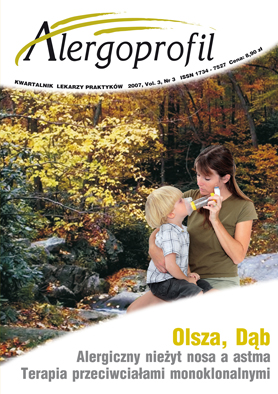The influence of allergic rhinitis on asthma
Main Article Content
Abstract
The majority of children with asthma have a history or evidence of rhinitis and 19% to 40% with persistent rhinitis have or develop asthma. Rhinitis frequently precedes asthma, is a risk factor for the development of asthma and is associated with increased severity of asthma. Asthma and rhinitis are considered to be inflammatory disorders of the airway. Although the inflammation of the nasal and bronchial mucosa may by similar airway smooth muscle contraction plays a dominant role in asthma while nasal obstruction is largely due to hyperemia in rhinitis. Both asthma and rhinitis have the same risk factor. Anti-inflammatory agents including glucokorticosteroides and leukotriene modifiers can be effective in both conditions. Treatment of rhinitis improve asthma symptoms. For these reasons the presence of asthma must be considered in all patients with rhinitis and presence of rhinitis must be considered in all patients with asthma.
Downloads
Article Details
Copyright: © Medical Education sp. z o.o. This is an Open Access article distributed under the terms of the Attribution-NonCommercial 4.0 International (CC BY-NC 4.0). License (https://creativecommons.org/licenses/by-nc/4.0/), allowing third parties to copy and redistribute the material in any medium or format and to remix, transform, and build upon the material, provided the original work is properly cited and states its license.
Address reprint requests to: Medical Education, Marcin Kuźma (marcin.kuzma@mededu.pl)
References
2. Rachelefsky G.S.: National guidelines needed to manage rhinitis and prevent complications. Ann. Allergy Asthma Immunol. 1999; 82: 296-305.
3. Juniper E.F., Guyatt G.H., Dolovich J.: Assessment of quality of life in adolescents with allergic rhinoconjunctivitis: development and testing of questionnaire for clinical trials. J. Allergy Clin. Immunol. 1994; 93: 413-423.
4. Lack G.: Pediatric allergic rhinitis and comorbidity disorders. J. Allergy Clin. Immunol. 2001; 108 (sup.1): S9-15.
5. Alergiczny nieżyt nosa i jego wpływ na astmę. Raport ARIA. Med. Prakt. 2002: 1-263.
6. Lai L., Casale T.B., Stokes J.: Pediatric Allergic Rhinitis: Treatment. Immunol. Allergy Clin. N. America 2005; 25: 283-299.
7. Bousquet J., van Cauwenberge P., Ait Khaled N. et al.: Pharmacologic and anty-IgE treatment of allergic rhinitis. ARIA update (in collaboration with Ga2LEN). Allergy 2006; 61: 1086-1096.
8. Leymaert B., Neukirch C., Kony S. et al.: Association between asthma and rhinitis according to atopic sensitization in a population-based study. J. Allerg. Clin. Immunol. 2004; 113: 86-93.
9. Blair H.: Natural history of childhood asthma: 20-year follow-up. Arch. Dis. Child. 1997; 52: 613-616.
10. Greisner S., Settipane R.J., Settipane G.A.: Co-existence of asthma and allergic rhinitis: a 23-year follow-up study of college students. Allergy Asthma Proc. 1998; 19: 185-188.
11. Rowe-Jones J.M.: The link between the nose and lung, perennial rhinitis and asthma-is it the same disease? Allergy 1997; 52(supl.): 20-28.
12. Thomas M., Sazonov-Kocevar V., Zhang Q. et al.: Asthmarelated health care resource use among asthmatic children with and without concomitant allergic rhinitis. Pediatrics 2005; 15: 129-134.
13. Togias A.: Rhinitis and asthma: evidence for respiratory system integration. J. Allergy Clin. Immunol. 2003; 111: 1171-1183.
14. Gaga M., Lambrou P., Pini H. et al.: Nasal mucosa cell profile in asthma. Allergy 1998; 53(supl.): S110.
15. Busse W.: Epidemiology of rhinitis and asthma. Eur. Respir. Rev. 1997; 7: 284-285.
16. Ciprandi G., Vizzaccaro A., Cirilio J. et al.: Increase of asthma and allergic rhinitis prevalence in young Italian men. Int. Arch. Allergy Appl. Immunol. 1996; 111: 279-283.
17. Bugiani M., Canosso A., Migliore E. et al.: Allergic rhinitis and asthma comorbidity in survey of young adults in Italy. Allergy 2005; 60: 165-170.
18. Lundback E.: Epidemiology of rhinitis and asthma. Clin. Exp. Allergy 1998; 28(supl. 2): 3-10.
19. Pedersen P.A., Weeke E.R.: Asthma and allergic rhinitis in the same patients. Allergy 1983; 38: 25-29.
20. Gaga M., Lambrou P., Papageorgiou N. et al.: Eosinophils are a feature of upper and lower airway pathology in nonatopic asthma, irrespective of the presence of rhinitis. Clin. Exp. Allergy 2000; 30: 663-669.
21. Tagias A.: Systemic immunologic and inflammatory aspects of allergic rhinitis. J. Allergy Clin. Immunol 2000; 106: 247-250.
22. Illonidas G., Varela M., Kakoulidis J. et al.: Bronchial hyperreactivity (BHR) in patients with seasonal and perennial allergic rhinitis. Eur. Resp. J. 1997; 10(supl.25): S352.
23. Downie S.R., Anderson M., Rimmer J. et al.: Association between nasal and bronchial symptoms in subjects with persistent allergic rhinitis. Allergy 2004; 59: 320-326.
24. Ramsdale E., Morris M., Roberts R. et al.: Asymptomatic bronchial hyperresponsiveness in rhinitis. J. Allergy Clin. Immunol. 1985; 75: 573-577.
25. Verdiani P., Di Carlo S., Baronti A.: Different prevalence and degree of nonspecific bronchial hyperreactivity between seasonal and perennial rhinitis. J. Allergy Clin. Immunol. 1990; 86: 576-582.
26. Boulet L.P.,Turcotte H., Boutet M. et al. Influence of natural antigenic exposure on expiratory flows, metacholine responsiveness and airway inflammation in mild allergic asthma. J. Allergy Clin. Immunol. 1993; 91: 883-893.

